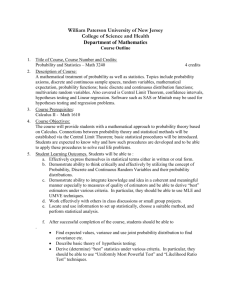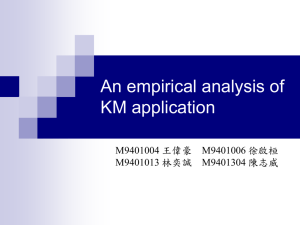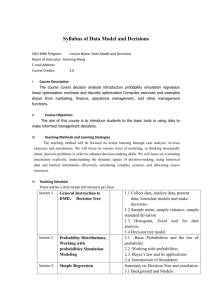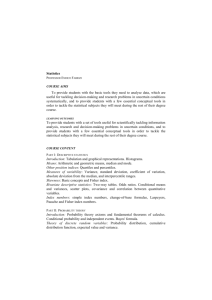Suppose that you have two variables, y and x, related by a linear
advertisement
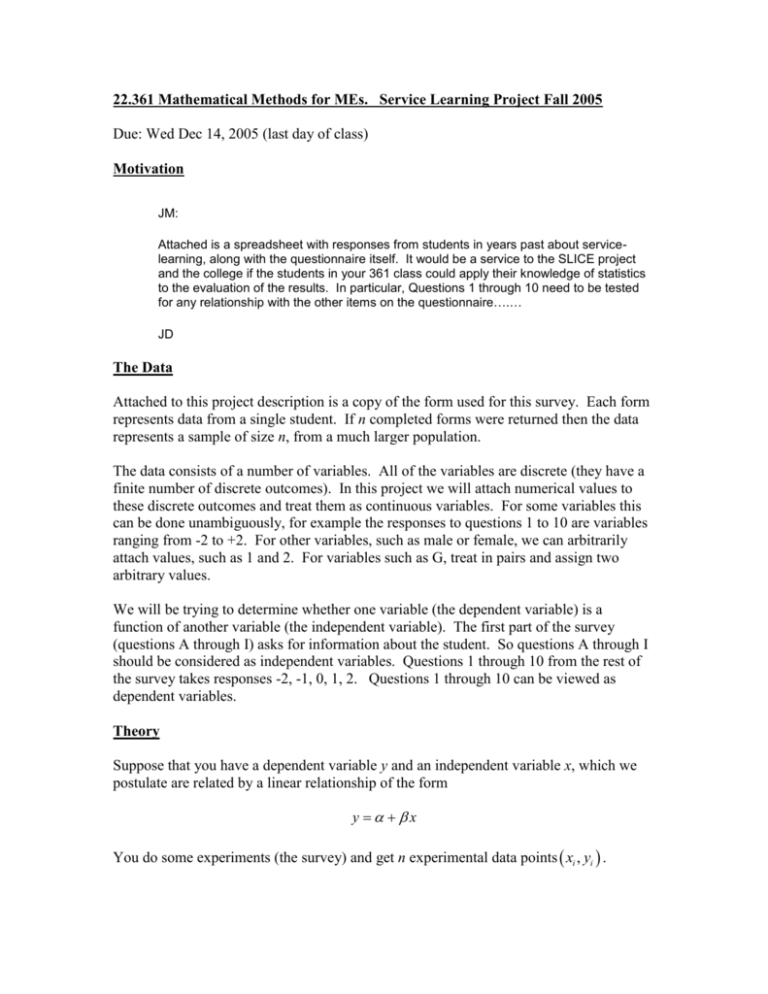
22.361 Mathematical Methods for MEs. Service Learning Project Fall 2005 Due: Wed Dec 14, 2005 (last day of class) Motivation JM: Attached is a spreadsheet with responses from students in years past about servicelearning, along with the questionnaire itself. It would be a service to the SLICE project and the college if the students in your 361 class could apply their knowledge of statistics to the evaluation of the results. In particular, Questions 1 through 10 need to be tested for any relationship with the other items on the questionnaire….… JD The Data Attached to this project description is a copy of the form used for this survey. Each form represents data from a single student. If n completed forms were returned then the data represents a sample of size n, from a much larger population. The data consists of a number of variables. All of the variables are discrete (they have a finite number of discrete outcomes). In this project we will attach numerical values to these discrete outcomes and treat them as continuous variables. For some variables this can be done unambiguously, for example the responses to questions 1 to 10 are variables ranging from -2 to +2. For other variables, such as male or female, we can arbitrarily attach values, such as 1 and 2. For variables such as G, treat in pairs and assign two arbitrary values. We will be trying to determine whether one variable (the dependent variable) is a function of another variable (the independent variable). The first part of the survey (questions A through I) asks for information about the student. So questions A through I should be considered as independent variables. Questions 1 through 10 from the rest of the survey takes responses -2, -1, 0, 1, 2. Questions 1 through 10 can be viewed as dependent variables. Theory Suppose that you have a dependent variable y and an independent variable x, which we postulate are related by a linear relationship of the form y x You do some experiments (the survey) and get n experimental data points xi , yi . You perform a linear regression on your data and obtain the curve y a bx The parameters a , b are estimates (point estimates) of the parameters , . If you took the surveys from a different semester and/or with a different group of students you would get different values for a , b although you would expect that , would not change. In effect, a , b both become random variables. What distribution do they satisfy? Theorem (reference 1), Under certain assumptions, the random variables t nS xx (a ) 2 se S xx n x t (b ) S xx se Satisfy the Student-t distribution with n-2 degrees of freedom In this theorem, S yy S xy / S xx 2 s 2 e n2 n S xx xi x i 1 2 n ; S yy yi y 2 i 1 n S xy xi x yi y i 1 x 1 n xi n i 1 ; y 1 n yi n i 1 If we are trying to determine whether y is a function of x then we are looking to see whether b is non-zero. Well, I can guarantee you that your regression will yield a nonzero value of b for virtually any data that you input. The question is, whether the calculated non-zero value is significant. One way we can address this is to calculate a confidence interval on . Something like: “based on the results of our regression we are 95% certain that lies in the range L to U ” . Then we can see how the range of compares with , and whether the confidence interval contains the point 0 (which corresponds to x and y not being correlated.) Project Requirements: 1. Form teams of 2 or 3. You can determine the members of your team. 2. Choose one of the questions 1 through 10 on the survey. The responses to this question will become your dependent variable y. 3. Choose 5 independent variables, x, that you think will have an effect on y, and which you think are interesting things to investigate. Explain your choice. 4. An Excel spreadsheet containing the survey responses will be emailed to you at your student email address. 5. Do a linear regression for each set of data. For each set of data produce a scatter plot with the regression curve superimposed on the data. 6. Calculate 95% confidence intervals for and in each case. 7. Make conclusions. 8. Produce a report. Use the Writing Workshop Guidelines for report writing (reference 2). Mostly I am looking for a report that I can to read, understand what you did, why you did it, and what conclusions you reached. I should not have to guess at stuff or consult pages of computer output. References: 1. Richard A Johnson, “Miller and Freund’s Probability and Statistics for Engineers”, 5th Ed., Prentice Hall, NJ, 1994, pp. 336-338 2. Guidelines on how to write technical reports, James B. Francis College of Engineering Writing Improvement Workshop, April 2001. (Attached to this project description) Questionnaire on Service-Learning Please answer according to what you really think, not what you think the instructor would like to hear. Please do not answer questions B, C, or D if you feel that answering them would give away your identity. Instructor will not see responses until after grades are turned in. Your responses are important for research. Thanks. Please circle one response: The amount of effort I put into the project in service to others was: 1 much more 2 more 3 same 4 less 5 much less than what I would have put in for an equivalent project not involving service. A. Please indicate the number of hours you work at a paid job each week _______ B. Age _______ C. Male ______(1) Female ________(2) D. Race or Ethnicity Caucasian ___(1) Other _______________(2) E. What kind of grades do you get on average? Excellent ___(1) Good ___(2) Average ___(3) Fair ___(4) Poor ___(5) F. During the past six months how many hours did you spend doing volunteer work? _________ G. For whom did you do this volunteer or community service? Family/friends _____(1) Community agency _____(2) Church _____(3) School _____(4) Health Care Facility _____(5) Other ________________________________(6) H. How many credit-hours of courses are you taking this semester? ________ I. How many hours per week on average did you spend on this course? _______ (Please turn over.) The following statements ask for your opinions about a range of topics. Please circle one of the numbers below next to each statement on a scale with the following end points: +2 if you strongly agree and -2 for strongly disagree. -2 -1 0 1 2 1. The problems of unemployment and poverty are largely the fault of society rather than of individuals. -2 -1 0 1 2 2. Individuals have a responsibility to help solve social problems. -2 -1 0 1 2 3. I don’t worry about what’s going on in the world because I can’t do anything about it. -2 -1 0 1 2 4. It is important to help others even if you don’t get paid for helping. -2 -1 0 1 2 5. Engineers should consider the needs of their customers. -2 -1 0 1 2 6. Engineers should put loyalty to their employer ahead of public safety. -2 -1 0 1 2 7. Maybe some people don’t get treated fairly, but that is not my concern. -2 -1 0 1 2 8. I can make a contribution to solving some of the problems our nation faces today. -2 -1 0 1 2 9. Engineers can help solve social problems. -2 -1 0 1 2 10. Service and academic coursework should be integrated. (Adapted from Colorado Student Service Learning Questionnaire)

